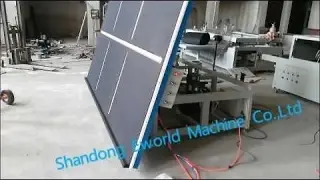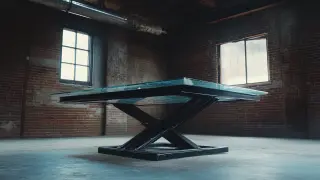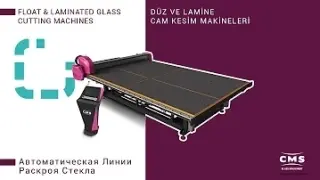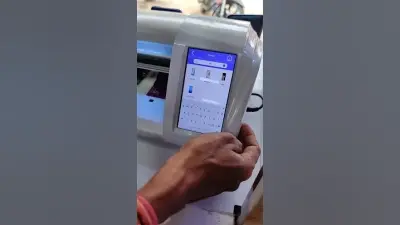As the glass cutting industry advances and develops, it becomes very critical for any business to be aware of new trends in this particular industry so as not to lag behind in competitiveness. Current market research indicates a compound annual growth rate (CAGR) of nearly 5.6% in the glass cutting machine market globally for the period of 2022-2025. Demand for such energy-efficient glass coupled with technological improvements in automation are responsible for this positive projection. Innovations such as the Glass Cutting Tilting Table symbolize the pinnacle of efficiency and productivity in manufacturing processes.
Shandong Eworld Machine Co., Ltd. is one of many newly founded companies in the dynamic industry of automatic glass machines since 2014. As part of its dedication to research and development, Eworld Machine provides a range of products of interest that include laser engraving machines and curved toughened glass bending machines. By keeping up with these transformations in market trends toward more automated solutions, buyers will well position themselves to make wise purchasing decisions involving products and services that best meet immediate needs while planning for technology advancements over time in the glass cutting arena.
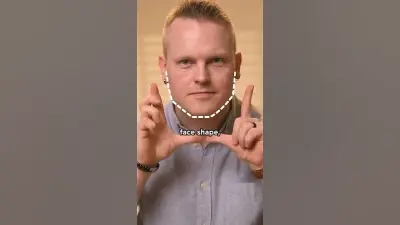
Current State of the Glass Cutting Industry: Insights and Innovations
The glass cutting industry, however, is undergoing a critical shift as a result of technological changes and changing consumer behavior. Currently, there are innovative technologies such as precision laser cutting and automated fabrication techniques, which are becoming increasingly popular. Aside from having sharper cuts, the technologies have improved efficiency through reduced production time and waste. By investing in high-tech machines, the industry is set in step with the future growing demand in design spaces-. architecture, automotive and furniture, for custom glass solutions. Moreover, sustainability has become an important aspect in the glass cutting industry. Manufacturers are using recycled glass and trying to reduce energy consumption while producing it, basically moving towards green production practices. This trend leads global changes towards sustainability and attracts businesses and consumers alike to eco-friendly products. Therefore, companies that will adopt eco-friendly materials and processes in glass cutting are expected to make great strides ahead of the rest in the market. Pent-up Demand will have Quick Releasing Mechanisms With Digital Tools Integration into Glass Cutting. Most significantly, the glass cutting process is incomplete without the use of digital tools. Software solutions designed for design and visualization are simply changing the way customers have to interface with manufacturers. It allows clients to visualize their projects in high detail before production, which can motivate a productionhouse toward a high degree of customer satisfaction and minimum error incidence. Given all these changes taking place, the glass cutting value chain must be equipped to stay informed and nimble in responding to these trends.
Emerging Trends Shaping the Future of Glass Cutting Techniques
The glass cutting industry is experiencing rapid changes as newer technologies and cutting-edge techniques emerge. As far as glass cutting processes are concerned, we can expect a major shift towards automation and precision in 2025. CNC (Computer Numerical Control) machines and robotic systems are coming to the fore, providing the ability to achieve very intricate designs and high rates of production. Such progress will not only enhance productivity but also give smoother and straighter cut edges, consequently reducing waste and rework.
Another significant trend that is leading the way into the future of glass cutting is sustainability. With increasing environmental concerns, companies are beginning to embrace green practices. They strive to utilize recyclable materials and energy-efficient cutting processes, reducing their ecological footprints. Furthermore, the advance of laser cutting technologies is enabling cleaner cuts using less energy; hence, they're being favored for environmentally-friendly manufacturing.
There has also been rising interest from the market in custom and personalized glass products. With the introduction of state-of-the-art design software, glass cutters can afford their clients increasingly tailor-made solutions fulfilling specific aesthetic and functional criteria. This development is not only offering consumers applications sure to attract their interest; it is, in turn, opening windows for the businesses concerned to stand out amid intense competition. Understanding the implications of these trends will be of importance as we move forward for both producers and consumers in the glass-cutting market.
Sustainable Practices in Glass Cutting: A Shift Towards Eco-Friendly Materials
The glass cutting industry has started to undergo a major transformation as sustainability becomes critical to manufacturers and consumers alike. There has been increasing emphasis on environmentally friendly practices, and many companies are experimenting with innovative materials that minimize environmental impact. The recent discussions at the 2024 Forum on Ecological Civilization really drove the point of sustainable development home, underscoring initiatives that encourage the use of recyclable materials in various industries.
Alongside other global efforts, the movement for sustainable materials in glass cutting is slowly gaining traction among glass cutters and project designers. Producers are increasingly inclined toward greener alternatives that minimize waste and encourage recycling. Not only do these changes appeal to consumers who are environmentally conscious, but they fit into broader social objectives promoting ecological balance. As these global companies take up sustainable products, the next inevitable question that the buyers will weigh upon in 2025 is the investment in environment-friendly glass cutting solutions.
Beyond just glass cutting, sustainability is being taken on elsewhere too. Recyclables by Aditya Birla Group are but an example of a larger commitment across industries to less harmful, more sustainable solutions. These days, consumers are increasingly aware of the implications of their choices. It will be worth examining how these materials directly affect the health of both the user and the planet. So in their purchasing decisions, consumers can help the cause of a greener future as they navigate the changing landscape of the glass-cutting industry.
Technological Advancements: Tools Revolutionizing Glass Cutting Processes
The glass cutting industry is changing prominently due to technology. The other trend includes the introduction of optical components into cutting tools for higher precision and efficiency of glass processing. The global market for hand drill bits for generating various shapes of glass is expected to increase from $64 million in 2023 to $87 million by 2030, at a compound annual growth rate (CAGR) of 4.3%. This indicates a gradual increase in demand for higher technology drilling systems in the glass industry.
Innovatively, the technology of fibre optics is altering the way glass is processed. In high-performance computing systems, glass fibers are replacing copper wires as companies seek to enhance data transmission. Such improvement not only makes the processing units work more efficiently but also leads to the development of advanced tools for glass cutting. This trend means quite an advanced approach used by the manufacturing sector to complete complex designs and precision requirements.
The increasing hardness and durability of synthetic diamonds in cutting tools deserve mention. As the hardest natural material, diamonds offer a clear advantage in precision machining, enabling glass cutters to achieve detailed finishes previously unthinkable. With continued market change, these new technological advances are poised to reshape how glass cutting is done, smartly interfacing consumer and manufacturer.
Smart Buying Tips: Selecting the Right Equipment for Your Needs
The glass-cutting sector is continuously transforming, and the selection of suitable equipment can significantly affect one's efficiency and productivity in cutting glass. Hence, as we look ahead to 2025, it will be increasingly crucial to familiarize oneself with technological trends and make suitable purchasing decisions. For example, a recent industry report indicates that productivity from advanced automated glass cutting machines is projected to be around 30% higher than that of traditional methods; hence, it is safe to claim a general trend towards advanced tools that further enhance precision while reducing wastage.
In smart buying decisions, keeping your needs and scale of operations in mind is essential. A smaller workshop benefits from modularity that offers flexibility and cost savings. Some recent insights suggest that modular systems are a growing trend, accounting for more than 25% of new sales in 2023. These systems can upgrade and expand without replacing the whole unit, making them a good investment for any growing business.
Also, look out for increased promotion and sales of software integration with glass cutting equipment. More than 40% of companies benefited from increased operational efficiency due to software-managed operations, suggesting that investing in solutions laced with software capabilities may yield positive results and give a competitive edge. By prioritizing everything mentioned above and remaining astute, you may well have a smart choice based on your needs in the glass cutting trade.
Understanding Market Demand: Key Factors Influencing Glass Cutting Sales
This is about understanding the trends in the glass cutting business. With an eye on the impending 2025, knowledge about the trends will help evaluate the purchasing decisions to be made. One such trend altering the market is the fast-increasing demand for specialized glass products, especially Low-E (Low Emissivity). This glass both increases the energy efficiency of buildings and responds to the consumer's escalating concern about sustainability. This demand for Low-E glass is aligned with the environmental trends that have been prevailing in the greater market: stamping consumer preferences and thereby forcing manufacturers into innovation and competition.
Another trend that is decidedly worth mentioning is the ever-increasing consolidation of the industry with the injection of seasoned executives to lead sales strategies. Recent appointments at firms such as Sterling Cut Glass and Thompson Innovative Glass reflect the desire to expand market reach and develop dynamic sales channels. The certain emphasis on skilled sales leadership signals these companies recognizing the importance of understanding customer needs and market insights to increase sales as they try to navigate current buyer behavior. It is against this background of change that buyers would do well to keep their ears to the ground about these developments and figure on how they could use this knowledge to their smart buying decisions in the changing glass cutting market.
Cost-Efficiency Strategies for Small Businesses in the Glass Industry
Small business traders are expected to adopt cost-efficiency options taking into account the glass cutting industry-2025 trends to stay bright in the face of stiffening competition and changing market dynamics. There is an indication that the clear conductive film market will grow big over the next few years due to the use of different materials like Indium Tin Oxide (ITO), silver nanowires, and carbon nanotubes. The diversification in the free space also opens doors for small companies to make improvements in their product offering with new product innovations, all geared toward cutting costs.
According to recent studies, it has also been noted that a remarkable increase in photo-voltaic-glass would correspond with an increasing installation capacity of solar panels, increased by the entry of double-glass technology. This implies that there will be an ample opportunity for small businesses in the glass industry to invest in the latest technologies and production lines to enhance efficiency and reduce the accumulation of waste. For example, ITO-coated PET substrates can give appealing glass products in terms of their signatory electrons to low-profile, environmentally conscious consumers.
Furthermore, there is much to gain from integrating IIoT solutions by small businesses if they are to break free from endless cycles of digital transformation. In addition to data analytics and automation, one operational area is financial rewards due to increased power or decreased operational costs. Changes will occur in an attempt to evolve in conjunction with glass cutting, hence small businesses will need to bring, with all their smarts, a future worth sensible powered choices.
Future Sales Forecasts: What to Expect in the Glass Cutting Market by 2025
There are high chances of transformation in the glass cutting market by 2025 because of multiple factors such as new technologies, sustainable practices, and changes in customer preferences. Sales forecasts indicate sustained growth, especially with demand for specialist glass products in construction, automotive, and decorative applications. Even with the increasing levels of artistic building design integrating glass elements, the market will further grow side by side with advances in cutting techniques that promise precision and efficiency.
Trend analysis shows that eco-friendly methods are on the rise in the glass cutting industry. Use of sustainable raw materials and processes by manufacturers is expected to appeal to the environmentally-conscious among both consumers and businesses. These trends not only support the global sustainability drive but also increase the longevity and quality standards of glass products. As the industry undergoes change, buyers should be cognizant of such developments so that their purchases reflect concerns for both quality and environmental impact.
For smart buying practice, consumers should prioritize suppliers who will demonstrate innovation and sustainability. With an understanding of the technologies involved in glass cutting, such as waterjet cutting or laser technology, buyers will be more inclined to choose a product with maximum performance and durability. Keeping up with trends in the glass cutting business would be very important in making selection decisions for future-ready investments.
FAQS
The glass cutting industry is being transformed by a growing focus on sustainability and eco-friendly practices, as manufacturers and consumers prioritize environmentally responsible materials.
Manufacturers are increasingly exploring innovative and greener alternatives that minimize waste and promote recycling in response to consumer demand for sustainable products.
The integration of optical components in cutting tools is enhancing precision and efficiency in glass processing, marking a significant trend in technological advancements in the industry.
Fiber optic technologies are revolutionizing glass processing by replacing copper wires, optimizing data transmission, and enabling more sophisticated glass cutting tools.
Synthetic diamonds are gaining popularity in cutting tools due to their exceptional hardness and durability, allowing glass cutters to achieve highly precise finishes that were previously unattainable.
The increasing demand for Low-E (Low Emissivity) glass, which improves energy efficiency and responds to consumer sustainability focus, is significantly influencing market trends in glass cutting.
Companies are consolidating and appointing experienced professionals to lead sales strategies, reflecting the importance of effective market understanding and customer needs in adapting to changing buyer behavior.
Consumers should consider the trends towards sustainability and technological advancements in the industry to make informed purchasing choices that align with ecological goals.
As the glass cutting market evolves, buyers should stay informed about innovations and market trends to leverage this knowledge for smart purchasing decisions.
The industry's focus on sustainability encourages consumers to prioritize eco-friendly options in their purchasing decisions, contributing to both personal and planetary health.

Home
About Us
Products
UPVC PVC Window Machine
Aluminum Window Machine
Glass Cutting Machine
Glass Edging Machine
Insulating Glass Machine
Glass lifting machine
Glass Washing Machine
Glass Laminating Machine
Glass Sandblasting Machine
Glass Drilling Machine
CNC Glass Working Center
CNC Non-Metal Cutting Machine
The Other Glass Machinery
Application
Download
News
Contact Us

